Antenna tuner
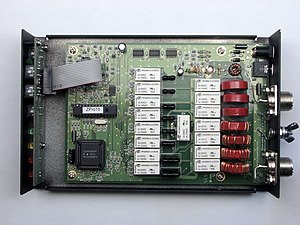

An antenna tuner, transmatch or antenna tuning unit (ATU) is a device connected between a radio transmitter or receiver and its antenna to improve the efficiency of the power transfer between them by matching the impedance of the equipment to the antenna. An antenna tuner matches a transceiver with a fixed impedance (typically 50 ohms for modern transceivers) to a load (feed line and antenna) impedance which is unknown, complex or otherwise does not match. An ATU allows the use of one antenna for a broad range of frequencies. An antenna plus matcher is never as efficient as a naturally resonant antenna due to additional induced losses on the feed line due to the SWR (multiple reflections), and losses in the ATU itself, although issues of pattern and capture area may outweigh this in practice. An ATU is actually an antenna matching unit, as it is unable to change the resonant frequency of the aerial. Note that similar matching networks are used in other types of equipment, such as linear amplifiers to transform impedances. See impedance bridging for details.
Basic principle of wide-band designs
For systems which need to operate over a wide frequency range such as a power amplifier operating over the range 1 MHz to 30 MHz in some solid state designs a series of wide band transformers wound on ferrite cores can be used. This design has the advantage of not requiring any tuning when the operating frequency is changed. This type of design can also be used to match an antenna to a transmission line, it has the advantage of not requiring any tuning but it has the disadvantage of not being capable of fine adjustment. These networks can be used to extend the useful range of a conventional narrow band ATU.
In solid state RF power amp design these networks are useful because MOSFETs and bipolar transistors are designed to operate with low resistance loads. Valved RF amplifiers are very different because the load resistance which a valve is designed to operate with is normally much greater, hence for power designs the circuit designs are often very different.
Below is shown for example an autotransformer which has three identical windings on a ferrite core. If the right hand side is connected to a resistive load of 10 ohms, then at each of the left hand terminals a source of different impedance can be attached.

Basic principle of narrow-band designs
Devices based upon both lumped components and transmission lines can be purchased or constructed. The most simple example of a transmission line based system is the transformer formed by a quarter wavelength of mismatched transmission line. For example if a quarter wavelength of 75 Ω coaxial cable is linked to a 50 Ω load then the SWR in the 75 Ω quarter wavelength of line can be calculated to be 75 Ω / 50 Ω = 1.5, the quarterwavelength of line transforms this mismatched impedance to 112.5 Ω (75 Ω x 1.5 = 112.5 Ω). For more details please see the Smith chart.
The basic circuit required when lumped capacitances and inductors are used is shown below.
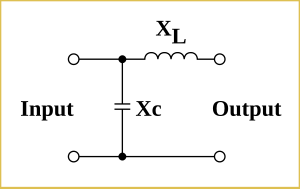
This basic network is able to act as an impedance transformer. If the output has an impedance consisting of Rload and jXload, while the input is to be attached to a source which has an impedance of Rsource and jXsource.
Then
and
In this example circuit XL and XS can be swapped. All the ATU circuits below serve to create this network which exists between the systems with different impedances.
For instance if the source has a resistive impedance of 50 ohms while the load has a resistive impedance of 1000 ohms then.
If the frequency is 28 MHz then
As,
then,
So,
While as,
then,
How it works
A parallel network consisting of a resistive element (1000 Ω) and a reactive element (-j 229.415 Ω) will have the same impedance and power factor as a series network consisting of resistive element (50 Ω) and a reactive element (-j 217.94 Ω).

By adding another element in series which has a reactive impedance of +j 217.94, the impedance is 50 ohms (resistive).

Types of ATU
Ultimate Transmatch
Classic circuit
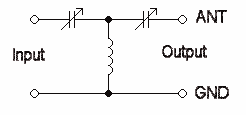
The Ultimate Transmatch is a good circuit with an unfortunate name, because a better transmatch called the SPC (series parallel capacitor) circuit was designed after it. In all three designs, the GND terminal is the terminal where the earth plane (ground plane) of an antenna should be wired while the ANT terminal is where the vertical element of a Marconi aerial should be attached. The configuration, although capable of matching a large impedance ratio, is a high-pass filter and will not attenuate spurious radiations above the cutoff frequency.
How it works
For example, imagine source impedance of 200 ohms and a resistive load of 1000 Ω which is connected via a capacitor with an impedance of -j 200 Ω to the inductor of the transmatch. Through vector mathematics it is possible to transform this into a parallel network consisting of a resistance of 1040 Ω and a capacitor of admittance 1.9231 x 10−4 (Xc = 5200 Ω).
In the following calculations all phase angles are expressed in degrees, rather than in radians. Start with the resistive load (RL) of 1000 Ω which is in series with Xc -j 200 Ω.
Phase angle
Y = 1/Z = 9.8058 x 10−4
To convert to a parallel network
If for a moment the reactive part is ignored, then a 1040 to 200 Ω transformation is needed. According to the equations above an inductor of +j 507.32 Ω is needed. If the effect of the capacitor (from the parallel network) is taken into account then an inductor of +j 462.23 Ω is needed. The system can then be transformed by the mathematics into a series network of 199.9 Ω resistive and +j 409.82 Ω. The mathematics required for this step are very closely related to the above mathematics.
To finish off the ATU a capacitor (-j 409.82) is needed to finish off the network.


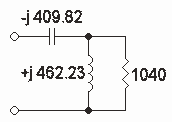
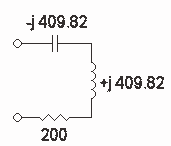

Pi network
This pi network can be used; it has the same function as the Ultimate Transmatch.
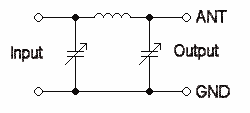
SPC

Connecting an ATU
Typically the ATU is connected between the antenna and the radio transmitter or receiver.[1] More specifically, the ATU can be connected between the feedline and the antenna to minimize loss, or between the feedline and the radio for convenience. However, SWR in the feedline must be considered in this second configuration.
It is a common misconception that high standing wave ratio (SWR) in and of itself causes loss. This is not the case.[2] An antenna with a high SWR (e.g. 4:1) when properly configured with an ATU could have only a few percent additional loss compared to an intrinsically matched antenna.[3] The ATU essentially redirects the reflected energy back along the feedline and antenna path. The additional losses come from the inherent losses within the feedline and antenna itself. SWR causes feed line losses to be multiplied. Low loss feedline would have minimal loss when tuned with an ATU whereas a "lossy" feedline/antenna combination of the same SWR could have significant loss.
Without the ATU, SWR from a mismatched antenna could cause reflections of power back into the transmitter, which will cause heating in the transmitter and significant power loss.
While modern solid state power stages do not like an SWR above 1.5, in reality an antenna VSWR of 2 means 11 percent of power is reflected and 89 watts sent forward through the antenna. Tube amplifiers using a Collins filter could easily remedy this.
Sample application: multiband shortwave transmitter
One of the longest lasting applications for dedicated antenna tuners is in high power shortwave broadcasting transmitters (50 kW+), where antenna tuning is a must due to frequent waveband changes. Every multiband shortwave transmitter sold since the 1950s has had one as part of its design. Most notably, some designs used a miniature railroad system to swap out capacitors as the longer wavelengths demanded larger capacitors.[citation needed]
Most antennas used in high power shortwave broadcasting are HRS type antennas, where the radiating elements are of a fixed length and the resonance of the antenna is optimized for only one or two bands. It typically takes about one minute for a modern antenna tuning unit to adapt to a frequency change in a broadcast band, and about two minutes to adapt to a change of two bands plus or minus. Some wideband shortwave broadcasting antennas don't need antenna tuning units; namely the Log Periodic type.
References
- ^ Dave Miller, "Back to Basics". QST, August 1995
- ^ M. Walter Maxwell, Reflections: Transmission Lines and Antennas. Newington, Connecticut: American Radio Relay League (1990) ISBN 978-0-87259-299-5
- ^ Jerry Hall, ed. ARRL Antenna Book. Newington, Connecticut: American Radio Relay League (1988), p. 25-18ff. ISBN 978-0-87259-206-3
Bibliography
- An introduction to Antenna Theory (BP198), H.C Wright. Bernard Babani, London, 1987.
- The Radio communication handbook (5th ed), RSGB, 1976, ISBN 0-900612-58-4.
- Ulrich L. Rohde : "Die Anpassung von kurzen Stabantennen für KW-Sender " (Matching of short Rod-Antennas for short-wave transmitters), Funkschau 1974, Issue 7.
- Ulrich L. Rohde : "Match any Antenna over the 1.5 to 30 MHz Range with Only Two Adjustable Elements ", Electronic Design 19, September 13, 1975













